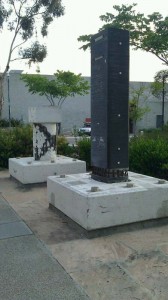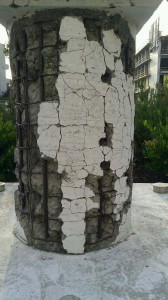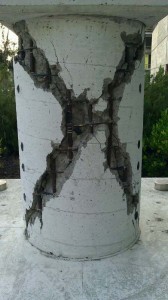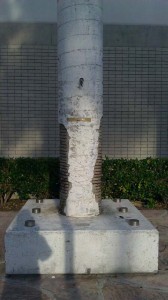Visitors to this part of the UCSD campus won’t forget that California is Earthquake country. Set at the edge of a walkway next to the landscaping are these pillars that have undergone simulated tremors on a jumbo shake table that can deliver a massive series of movements emulating the Big One.
Another hint that this is California lies in the fact that these are pillars modeled on those that keep our freeways high in the air. The structures lab here has worked with transportation agencies to try to develop safer structural components for bridges and overpasses.
During severe shaking the tremendously strong yet fragile concrete disintegrates, leaving the supporting steel which has flexibility but comparatively little strength to keep structures aloft. I wouldn’t want to be anywhere near a freeway with compromised supports like this.
The solution the structural engineers came up with is to wrap the columns in a material that bandages the concrete and keeps it from pulverizing into gravel. It almost seems too obvious a thing to do, but it looks like it really works when you compare these two pillars to the first ones I showed.
So, here in the middle of clipped hedges and mounds of orange lion’s tail, you have these six pillars, standing around like decaying Grecian columns or remnants of a garden folly in an Eighteenth-Century English garden.
This image is of the Temple of Harmony, a folly on the grounds of Halswell House, Goathurst, Somerset, courtesy of the Wikimedia Commons. (Image by Stronach, released to the public domain. Thank you Stronach!) Even though it’s far from this land with the shakes the Temple apparently has some trouble standing up. The Wikipedia description states that “it now has the addition of a tie bar, a long retaining bolt that runs through the structure from one side to the other, helping to keep it together.”
Maybe the Halswell Park Trust could take a clue from the clever Californians and wrap the Temple in fiberglass, though, yeah, it might look a little more like the work of Christo than that of Thomas Prowse, its original architect…







I don’t remember these from the campus when I was a student there in the 90’s. Must be new. I think they look kind of cool. They remind me of the goofy post-modern art that is all over the campus.
Your photos of those columns bring back Loma Prieta memories of the collapsed Cypress freeway. That particular elevated freeway was removed, to the benefit of the community it had cut through. I vote for Christoswathing columns for safety, in colors.
Second Maggie’s comment! It could be a real opportunity for safety and public art to join forces! Think if freeway structures were no longer eyesores, AND they were safer! I hate when I get stopped at a red light under a big structure–I think about earthquakes every single time it happens.
Fascinating post!
Even though I remember a couple of really scary earthquakes, which ever one was in 1971, and the Northridge, I would rather have those than tornados any day, …granted, I never was on a freeway when it was collapsing as in SF.
It’s amazing to see that the concrete in these columns seems to be pulverized deep into the interior. I like the X, a motif that is so intrinsic.
Ryan, I think these were there by the late 90s but not sooner. While I love a couple of the pieces of art on campus I’ll admit to finding these columns more entertaining and interesting than some of the others.
Maggie, I can see Loma Prieta in these columns, as well as Northridge. After I made the Christo comment I remembered that I’d seen a photo from the late 70s by Richard Misrach of a tarped highway construction site that was subtitled something like, “Homage to Christo.”
Jess, thanks! There’s so much around us where being in the wrong place at the wrong time would be a pretty unfortunate thing. I think about it when I’m in a sidewalk, for instance, with cars gunning to get going all around me…
Sue, 1971 was the first California rocker that I remember. A brother of mine was so terrified because this was the height of the the time they were talking about California splitting off and falling into the ocean. Later, when Northridge hit, my relatives that lived near the epicenter escorted me around town for the death & destruction tour not long after it happened. It was stunning to see reinforced concrete seemingly bend as it did on the supports of the collapsed parking garage at CSUN.
Had to laugh about the ‘death & destruction tour’, James. My Dad liked to take the family on drives to see new building projects around the greater LA and SD area, which included such a tour of the Baldwin Dam Disaster.
He was an engineer who explained in detail to us kids (in itself a mild form of child abuse) all the reasons and effects of the various projects, spectacles and in this case disaster site.
An aside: I remember one particular harrowing trip in the family Cadillac, all six of us present, on a ride over the ‘Old Ridge Route’ which in 1970 was in decrepitude.
We could see areas where the dirt was eroded out from under the road, the tires sinking and my mother saying, warningly, “Walt! …Walt!” as she leaned in towards the bank side of the road.
All the while, my Dad was explaining happily how he used to travel this road in his old ’49 Cadillac and how they determined the best way to build new freeways. I still remember how relieved I was to reach the town of Castaic.